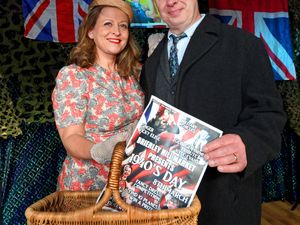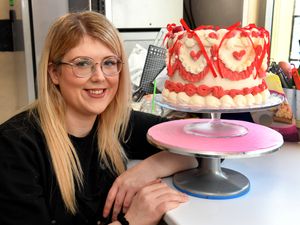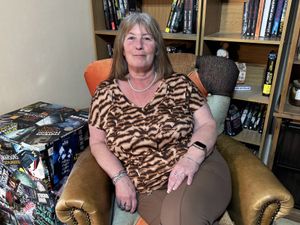Meet Telford Tigers ice hockey team
It’s a fast-paced and exciting game which is attracting more and more fans. Weekend gets to grips with ice hockey . . .
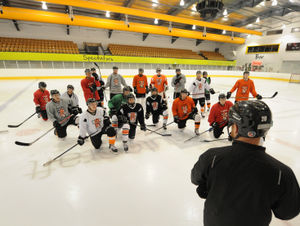
It’s the coolest and fastest team sport in the world. Ice hockey players move at impressive speeds of more than 20mph across the rink with the precision of figure skaters.
It’s a fast-moving game, played with a puck, which is guided and pushed around the rink with remarkable force.
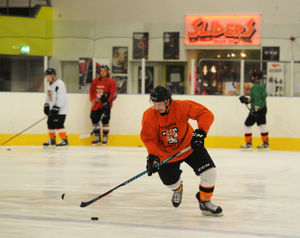
Spectators love the sheer speed and skill shown by the two heavily-padded teams as they battle it out for glory on the ice.
And while it’s probably never going to be as big in this country as it is in North America, the sport does have a loyal following here – and none more so than those connected with Telford Tigers.
It’s generally accepted that the game began its modern era because of a match that was played by Englishmen on the frozen expanse of Kingston Harbour, Ontario in 1860.
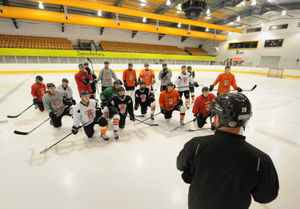
This was the first time a puck instead of a ball was used and so is accepted as the origin of the game as completely divorced from field hockey.
These first players were Crimean war veterans from the Royal Canadian Rifles.
In 1879, two students at McGill University in Montreal devised the original rules and regulations and a square rubber puck was used with nine players to each side.
The game was taken to Ottawa in 1885 and with the climate of Canada excellent for winter sports, ice hockey became more popular and developed across the country but didn’t gain a foothold in the USA until the advent of refrigerated rinks.
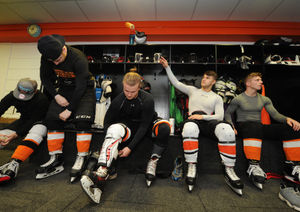
Since then it has spread throughout the globe and, now, ice hockey is played in more than 55 countries worldwide from Andorra to Yugoslavia.
Telford Tigers were formed in 1985 following the opening of the town’s ice rink, attracting fans from across the Midlands and further afield.
The club has had much success since then but has also fallen on hard times more than once, having several different owners and guises in that time.
But the Telford Tigers name has lived on and is still here today attracting hundreds of fans to games with everyone associated with the club full of hopes of a bright future ahead.
“We have started from scratch this season and we are in a really strong position. We want to be there for the long-term so it’s all about building up the team so we get even stronger to compete in the league as well as entertain the fans,” says head coach and general manager Tom Watkins.
During his playing days, Tom was a product of the Durham youth system, enjoying spells in the north-east, and three seasons at Telford Tigers.
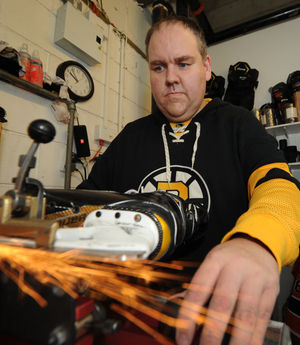
In 2000, Tom was recruited by Coventry Blaze and spent 10 seasons at the Skydome, winning a glittering array of Elite League honours.
He was also called up to play for Great Britain in three World Championships tournaments.
The 39-year-old returned to Telford in 2010 as a player-manager before becoming general manager earlier this year.
“I’ve been playing hockey since I was five. I love the game, it’s the world’s fastest game, it’s fast, it’s exciting and it’s physical.
“There is no better feeling than when you have worked together as a team to get the victory,” says Tom.
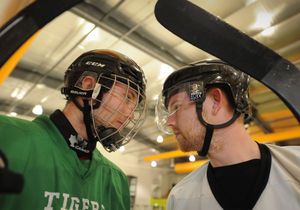
The club has two teams, known as Telford Tigers 1 and Telford Tigers 2, and they compete in the National Ice Hockey League (NIHL) Moralee N1 and NIHL Laidler N2 Divisions respectively. There are 14 first team players in Telford Tigers 1 and around 22 in Telford Tigers 2. Also, boosting the club are the under-nines, under-11s, under-13s, under-15s and under-18s sides.
“We are dedicated to training future generations. It’s important to us to have homegrown players and the development of the junior teams is key.
“We are developing players from a young age and they can benefit from the experience of senior players,” says Tom.
As well as Junior Tigers, it runs Learn to Play sessions on Tuesday evenings at the ice rink. They are intended to offer competent skaters a chance to sample the game with full kit and skates provided.
Club officials work with schools in Telford as well as further afield to teach youngsters the basic skills of ice hockey.
“It’s important to be part of the community and hopefully we can encourage some players of the future,” says Tom.

Between 400 and 1,000 loyal fans turn out for home matches at Telford Ice Rink with the size of the crowd depending on the fixture and the time of year.
The club, which secured its first league title, winning the First Division championship in a play-off against Cleveland Bombers, in the1987/88 season, has also been working to boost attendances by trying to attract new spectators to the sport.
This included handing out free tickets to students and staff at the University of Wolverhampton earlier in the season, aimed at encouraging those who may not have considered attending a match before to give it a try.
“When I first came to Telford, we were getting crowds of around 2,000. Now we get less than 1,000. People are more choosy about how they spend their time and their money. We appreciate any support but it would be nice to see more people.
“We are trying to entice more fans to the games. The idea is to give them a taste of a sport they may never have seen before. Hopefully they will enjoy the experience and will keep coming back.
“It would be great to see ice hockey on TV more here and for it to get more exposure.
“It’s massive in North America where it’s among the top three sports. It’s a shame it’s not such a big sport in England,” explains Tom.
Toronto-born skipper Jason Silverthorne, who has been integral for the Tigers over recent seasons, has started his fourth campaign for the club.
The 39-year-old, who is originally from Durham, has played sides in both his home country and the US as well as a number of clubs in the UK including Cardiff Devils and Hull Stingrays.
“I grew up with the sport in Canada and I have been playing professionally for 15 years. I played in the States before moving here. I love that it’s a challenging game, and no two games are ever the same which keeps it fresh and keeps it exciting.
“We are always challenging ourselves to be the best we can be every time we go out on the ice.
“We’ve got some really talented players and coaches this season and we’re all working together to improve. It’s a team effort.
“I’m enjoying it here in Telford. My family is settled here so it’s all going well,” explains Jason.
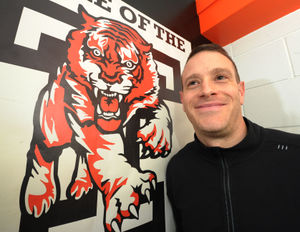
“Jason is a great role model, he is always happy to offer support to younger and less experienced players to help them improve their game,” adds Tom.
Making sure the squad of 14 first team players have razor sharp skates ready for training sessions or matches is equipment manager Andy Phillips, who’s duties include loading all of the kit ahead of away ties. “My job is to blend into the background, I make sure the players have everything they need to get on the ice when they need it.
“The idea is that they can just turn up and play, everything they need will be there for them,” explains the 44-year-old, who has been at the club for 23 years.
“I’ve been following the sport since 1989 and I haven’t missed a home game since. I love the sport.
“I’ve seen so many guises of this club and we’ve nearly disappeared from the face of the earth a few times in the years I have been following them.
“There have been some tough times but we’re looking really good at the moment. We’ve got homegrown players coming through. Everything is really positive,” adds Andy.
IT consultant Ian Howells, who’s 13-year-old son Thomas is with the Junior Tigers, is one of 20 volunteers lending a hand.
The 48-year-old is responsible for promoting the club, the website, merchandise and running the fan competitions such as ‘chuck a puck’.
“I’m passionate about hockey. It’s a sport that I’ve followed since 1985 when I was in my teens. I followed it through to my mid-20s, took a break, then came back to it five years ago,” says Ian, who lives in Telford
“It’s exhilarating to watch, it’s the fastest team sport there is and it’s great fun.”
A beginners guide to ice hockey. . .
A game is divided into three 20-minute periods of actual playing time, divided by two intervals of usually around 15 minutes. When a whistle is blown the clock stops.
Six players from each team are on the ice at any one time. The line up being; netminder, two defencemen and three forwards. These players can be changed at any time as the game is played at such a speed.
A team is usually made up of between 17 and 22 players. This consists of two netminders, four to six in the defence and three to four lines of forwards.
The netminder will usually remain unchanged throughout the game, but it’s quite common for him to leave the ice during the last seconds of a game.
This means there is no goalie and six outskaters on the ice in a risk-all effort to score. This usually happens at the end of a game where teams are separated by a single goal and can be very exciting.
Play begins with a face-off when the referee drops the puck in the centre circle between the sticks of the two centres. Other face-offs happen after a goal is scored and at other times after misplay. The puck only becomes dead when the whistle blows or it is hit over the barrier.
A goal is scored when the puck enters the net or goes across the goal line propelled by a stick. If the puck is kicked or thrown into the net there is no goal. Goal judges sit behind each goal and switch on a red light when a goal is scored.
The puck is circular, made of solid vulcanised rubber. A player may stop the puck with hand, body or skate at any time in any position. The puck must not be pushed forward except by skate or stick.
The space between goals is divided by blue lines into three zones; defence, neutral and attacking zones – each is a third of the playing area.
An attacking player may only enter the attacking zone behind the puck or puck-carrier. A pass cannot be made to an attacker from a team-mate who is outside the attacking zone. This is known as being offside and the whistle will be blown and a face-off taken.
Players are penalised for infringements of rules by being sent off the ice for two or more minutes according to the severity of the offence and no substitute can be made for the duration of the penalty, which he serves in a special penalty box.
The goalie does not serve his own penalties but a team-mate must sit in the box for most penalties given against him, except if he is thrown out of the game.
Offences include charging, elbowing, boarding, tripping, checking from behind, high sticks, interference, roughing and unsportsmanlike conduct.
Ice hockey players wear specialised equipment, which is specifically designed for safety. Players are well padded – they wear knee pads, shin, hip, elbow and shoulder guards, thick gauntlet-type gloves, long stockings that fit over the knee pads, padded shorts that lace up at the front and sweaters in team colours over everything.
Boots are stronger and different from figure skating boots. They have lower ankle support, reinforced toes and padded tongues. The blade has a plain point, is straight and narrow and now hollow ground. The two upright stanchions are higher on a hockey skate changing the centre of gravity.


